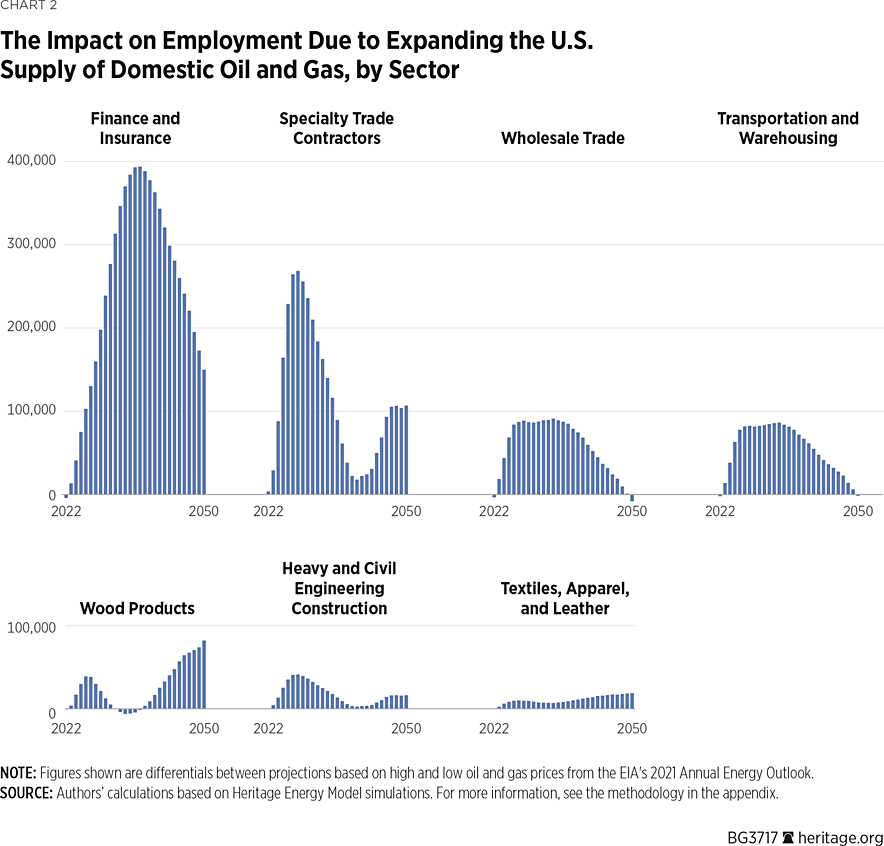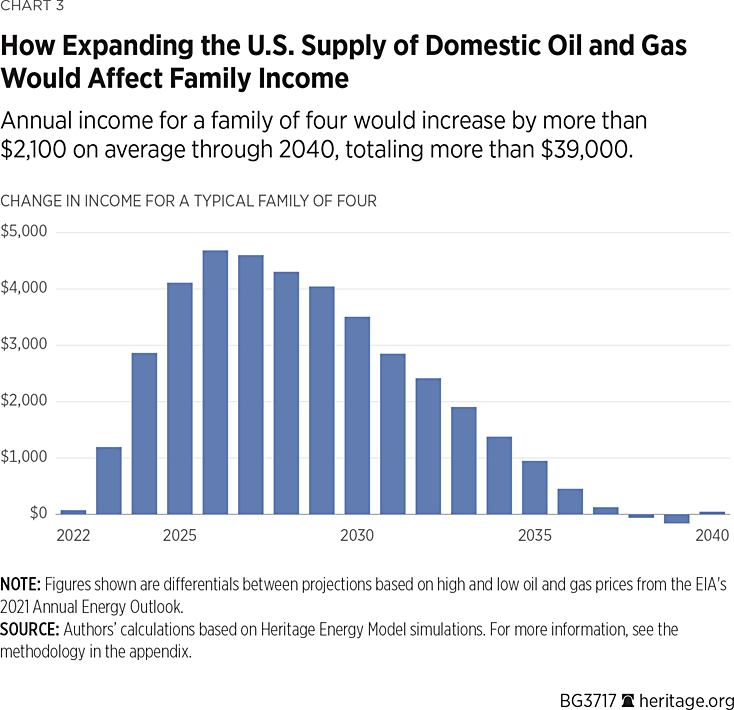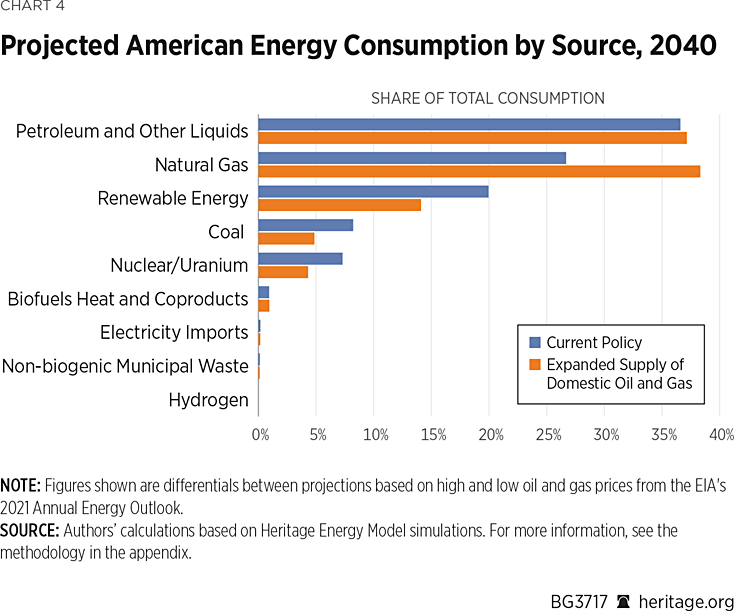American families and businesses today are paying some of the highest energy prices in decades. Because energy is essential to nearly every good and service that Americans use, they pay high energy prices not just at the gas pump and in utility bills, but also in the form of groceries, manufacturing and delivery of products, running a business, and countless other economic activities.
Policies matter, and the Biden Administration’s energy policies are making the situation much worse. Instead of cancelling much-needed pipelines and permits, adding red tape, and threatening energy producers with financial attacks, the President and Congress should pivot to policies promoting energy abundance. Developing the United States’ own enormous resources could provide the energy needed for American prosperity and international security beyond the end of the century. Our analysis shows that, compared to the energy-scarcity approach of the Biden Administration, pursuing an energy-abundance policy would have a trivial impact on global temperatures while increasing aggregate U.S. gross domestic product (GDP) by $3.4 trillion by 2040, or $39,000 per family of four.
Americans are blessed with abundant natural resources, such as coal, oil, and natural gas. Using these great resources would not only benefit America, but countries around the world. Just as increased prices drive up costs throughout the economy, the benefits of more affordable energy are widespread and have profoundly positive impacts.
Energy Use in the United States and the World
Energy is a fundamental component in virtually every aspect of society and is essential to countless economic interactions. Conventional fuels—coal, oil, and natural gas—meet 79 percent of Americans’ total energy needs.REF Petroleum meets 90 percent of Americans’ transportation fuel needs—energy used by automobiles, trucks, buses, trains, aircraft, and ships. Coal, oil, and natural gas meet 82 percent of global energy consumption for power, transportation, and heat, with the remainder met through a combination of hydropower, renewable energy technologies, and nuclear power.REF The share of conventional energy use has remained roughly unchanged for decades, even as global consumption of energy has increased, and governments have heavily subsidized renewable energy technologies to allow them to enter energy markets.REF
Global energy needs are expected to increase in the decades to come. The U.S. Energy Information Administration’s (EIA’s) International Energy Outlook projects no scenario in which global demand for oil and natural gas does not increase through at least 2050.REF Coal use is expected to decline, but to persist as an important source of energy globally. Global energy use is expected to increase by 50 percent by 2050, driven in large part by the growing needs of developing nations. Many citizens of these countries still do not have access to electricity or enjoy anything near the standards of living that affordable, reliable energy has enabled in the United States and the rest of the developed world.
While no one knows what the future holds (very few expected the energy boom created by affordable, efficient hydraulic fracking technology), the EIA’s projections provide a useful framework for policymakers when thinking about the future.
President Biden’s Narrow Approach
Markets incorporate future expectations of scarcity and demand into prices, and to that end both restrictive pandemic policies and Russia’s invasion of Ukraine have contributed to the high energy prices that Americans are experiencing.REF However, energy prices were increasing long before the crisis in Ukraine and have considerably worsened.REF
In response to high energy prices, President Joe Biden has recast his climate policies as an agenda for energy independence. According to the Administration, the U.S. should not use the energy it has, but “accelerate the transition to clean energy” to achieve energy independence and protection from global energy markets.REF With this approach, policy must force a phasing out of the production and use of conventional energy and mandate aggressive adoption of wind power, solar energy, electrification, and alternative fuels, which the Administration presumes are comparable alternatives and solutions to global warming.REF Consequently, President Biden has paid lip service to the need for increasing energy production. At the same time, his Administration has continued to propose and implement regulations to delay and block development, production, distribution, and investment of oil, natural gas, and coal.
This strategy ignores the lessons of the past and replaces private initiative and finance with centrally planned and managed federal standards, regulation, tax policy, subsidies, and spending programs. The result is a very narrow conception of energy security depending primarily on a handful of politically preferred energy technologies.
Some of the many follies and costs of the Administration’s policy approach are detailed further in the Heritage Foundation Backgrounder, “The Unsustainable Costs of President Biden’s Climate Agenda.”REF The President’s vision of overhauling the American energy sector by regulatory fiat is historically unwise and deeply unrealistic about global energy markets or the diverse needs of energy consumers. It has already proved costly to the taxpayer,REF ignored serious reliability concerns to the electric grid,REF dismisses the unique vulnerabilities of the President’s preferred energy technologies and their supply chains,REF has failed Europe,REF and dismisses America’s vast energy wealth.REF
A Policy Agenda for Energy Abundance
In contrast to the Biden Administration’s energy policy of self-imposed austerity, American families and businesses would benefit greatly from energy abundance. The United States has abundant oil, natural gas, coal, and hydropower, as well as wind, solar, and nuclear energy, and a strong culture of innovation (though constantly beleaguered by crony-ist policies). Americans should be able to access that abundance in all its forms.
A policy of energy abundance would restore the freedom of Americans to invest in, explore and produce, build and operate the necessary infrastructure for, and use the types of energy that meet their needs. This freedom requires immediately withdrawing proposed regulations and rescinding finalized regulations that inhibit access or increase costs of producing and distributing conventional energy in service of Executive Orders 14008 and 13990 undergirding President Biden’s unilateral commitment to the costly and ineffective Paris Agreement.REF
A policy agenda that increases Americans’ access to America’s energy abundance would:
- Allow increased energy production on federal lands and in federal waters. Energy production on federal land and waters constituted 12 percent of American natural gas production and 24 percent of oil production.REF The Administration should immediately reinstate statutorily required sales on federal lands for new oil, coal, and natural gas leases, and should replace the half-hearted offshore plan it recently proposed with a more aggressive plan suited to meeting the country’s energy needs. In addition, Congress should make holistic reforms to streamline federal leasing and regulatory processes.REF
- Remove barriers to energy production on private and state landswhere most American energy production occurs. This includes removing new regulations on methane emissions from oil and natural gas production and distribution; blocking use of the social cost of carbon dioxide, as well as of other greenhouse gases (GHGs), to permit new projects and supporting infrastructure; and removing the threat of federal air quality standards that are likely to be weaponized to prevent new energy production.REF
- Relieve policy-induced chokepoints in energy distribution. Energy production requires pipelines to produce and distribute resources efficiently as well as shipping and processing facilities (such as refineries, liquefaction plants, and petrochemical cracker plants) to fabricate raw natural resources into useable energy for consumers. Policies that contribute to higher costs and supply-chain inefficiency are the Renewable Fuel Standard, the Jones Act, permitting under the National Environmental Policy Act, and politicization of pipeline construction.REF
- Allow Americans to invest in energy projects they believe will bring them good returns without fear of political retribution. This requires removing regulations to “de-bank” conventional energy companies; to micromanage federal pension investment plans to prioritize climate and “environmental, social, and governance” factors over financial benefit for employees; and to mandate disclosure of “climate risk” by public companies. While companies must remain free to offer financial products and services, policy reform must also remove threats from financial institutions in the private sector that are made in collaboration with, and re-enforced by, government officials. Protecting Americans’ ability to engage freely in energy markets also requires eliminating investment tax credits. Energy companies of all kinds should find the U.S. a welcome place in which to do business, free of cronyism and government favoritism.REF
- Protect consumer’s ability to choose energy sources. Markets incorporate expectations of future supply and demand into the price of energy. The government should neither force a transition of consumer use to politically preferred energy sources nor protect energy companies (renewable, conventional, or otherwise) from competition. This requires eliminating regulations to phase out the internal combustion engine in new light-, medium-, and heavy-duty vehicles; dozens of federal energy efficiency standards for household and commercial-grade appliances using natural gas and electricity; and executive orders to nudge private-sector purchasing and require federal procurement of GHG-emissions-free energy, technologies, and building materials.REF
- States also play an important role in advancing a policy agenda for energy abundance. State policies to mandate renewable energy, ban hydraulic fracturing or use of oil and natural gas products, and arbitrarily block pipeline infrastructure are not only misguided attempts to protect the environment, but actively work against access to resources that meet most Americans’ energy needs.REF
The Benefits of Energy Abundance
Undoubtedly there are benefits to energy abundance that are not easily quantifiable but clearly seen in the contrasting policies and experience of Europe. The European Union and Great Britain committed to centralized energy policies years ago to curtail their own production of natural gas, coal, oil, and (in some cases) nuclear energy, and have heavily subsidized wind and solar energy. Underperforming renewables have left European families and businesses heavily dependent on energy imports and with few options as they scramble to find alternatives to Russian energy for the immediate term and long term in light of Russia’s invasion of Ukraine and weaponization of energy.REF The result of such a politically designed and centrally regulated energy sector is a more fragile system where points of failure, instead of being an inconvenience, are catastrophic.
While it is hard to quantify the security and political implications, it is easier to capture the economic benefits of policies that allow energy abundance. To better understand these relationships, we modeled the economic impacts that increased energy production would have on American families and businesses—that is, the opposite approach of the Biden Administration. To quantify the economic impact of capitalizing on the vast U.S. oil and gas supply, we used the Heritage Energy Model (HEM), a clone of the EIA’s National Energy Model, to compare the economic impact of current policy to an alternative scenario of increased energy production. Details about the model are discussed in the appendix.
To approximate different policy approaches, we use the EIA’s Annual Energy Outlook, which makes projections of energy production, consumption, and prices. The EIA’s reference case assumes midpoint projections for energy resources and assumes that laws and regulations follow their statutory timelines. The EIA also produces two side cases where energy resources are assumed to be 50 percent higher and 50 percent lower than the reference case. Though these side cases are not intended by the EIA to model policy changes, they offer a glimpse of what associated changes might entail.
For an approximation of the trajectory of current policy under the Biden Administration, we use the EIA’s low supply case, which assumes higher energy costs and a gradual decrease in production through 2050. This low supply case is more reflective of the Biden Administration’s policy agenda to drastically curtail production and consumption of conventional energy to achieve its Paris Agreement commitments in the near term and reach economy-wide net-zero emissions by 2050. If anything, it is an underestimate of the Administration’s ideal policy scenario.
To approximate the alternative policy approach, we use the EIA’s high-supply case assuming that the recoverable shale oil and shale gas and their variants are 50 percent higher than EIA’s reference case in its 2021 Annual Energy Outlook. These simulations enable the analysts to model the impact of lifting burdensome regulations on energy production.REF The assumptions in the alternative scenario are quite reasonable. At current usage rates, the United States’ recoverable reserves are large enough for nearly a century of natural gas supply and two centuries of petroleum.REF A number of other assumptions are made in both scenarios and are discussed in detail in the appendix.
Our analysis shows that, compared to the energy-scarcity approach of the Biden Administration, pursuing an energy-abundance policy would:
- Increase aggregate GDP by $3.4 trillion by 2040 and $4.4 trillion by 2050,
- Increase aggregate GDP per family of four by $39,000 through 2040,
- Reduce gasoline prices by $0.20 per gallon in the short run and $0.60 per gallon by 2040, and
- Lead to an average employment increase of 1.1 million jobs.
Chart 1 shows the impact on employment, based on the Heritage simulation results, of lifting unnecessary regulations and taking advantage of the vast shale oil and gas resources in the United States.

The impacts are sizeable with a peak employment of 2.6 million more jobs, or an average of over 1.1 million more jobs compared to Biden Administration policy. The positive impacts on employment go well beyond the energy industry. The increased supply of energy, along with the associated decrease in price, reduce production costs in virtually every industry, which allows increased aggregate production and employment.REF Nearly every business in the U.S. uses energy as an input cost for its product, whether it is as simple as paying the electricity bill or using oil and natural gas feedstocks for countless consumer products. Thousands of products not normally thought of as energy products are made with oil, coal, and natural gas as feedstocks (for instance, fertilizers, steel, plastics, dyes, and pharmaceuticals). Consequently, reduced energy costs make U.S. businesses more efficient, competitive, and capable of investing in new productivity. Chart 2 shows just some of the industries that would be able to reap these massive benefits:

While individual Americans benefit as consumers of these products and services, the financial benefits for families are also quite apparent. Chart 3 presents the impact of increased energy production for the personal income of a family of four.

As Chart 3 illustrates, the GDP gains described above amount to an average annual gain of $2,100 for a family of four, amounting to over $39,000 through 2040. These gains can have major positive impacts on families in their daily lives. The HEM also finds that annual household electricity expenditures decrease by up to 5 percent compared to the low oil and gas supply baseline representing the Biden Administration’s policies. Additional energy savings are particularly impactful for Americans with lower incomes, who must devote a larger share of their budgets to meeting household energy needs.
Lastly, as gasoline prices have skyrocketed over the past year, a worthwhile focus is to understand how accessing American energy will affect gasoline prices here at home. The HEM forecasts gasoline prices on a per gallon basis.
The HEM forecasts that gasoline prices will increase over the next several decades under both the baseline and alternative scenarios. However, prices under the alternative scenario, assuming a greater supply of domestic oil and gas, are significantly lower, by as much as 50 cents per gallon in 2040. Under this alternative scenario, gasoline prices sharply decline in 2024 by more than 20 cents per gallon (an 8 percent reduction), decrease by more than 50 cents per gallon in the middle of the next decade (a 16 percent reduction), and subsequently decline by more than 60 cents per gallon by the year 2040 (a 20 percent reduction) compared to our low oil and gas supply baseline.
As with any globally traded commodity, the U.S. cannot completely isolate itself from changes in markets (nor would this be a beneficial policy objective as American customers benefit from the efficiency gains of international trade in energy resources and refining).REF However, just as increased production helped to minimize the impact of previous major disruptions in global oil production,REF expanding the presence of American oil in the markets will help to enable the United States, as well as other countries, to weather the storm induced by shocks to the global oil markets.
Does Taking Advantage of U.S. Oil and Gas Supply Affect the Climate?
Opponents of increased domestic production of conventional fuels have long argued that increased energy production would lead to increased GHG emissions both through the production process itself and as a result from GHG emissions from the use of the oil and gas extracted.REF According to our simulations, however, overall emissions in the high production scenario are reduced by over 20 percent in 2030 onwards with respect to 2005 levels. This reduction occurs with major economic benefits to American families and businesses compared to the far-reaching economic damage caused by the Biden Administration’s centrally planned, highly regulatory approach.REF
Analysis of energy consumption indicates that these reductions are due primarily to increases in natural gas consumption, which has a lower carbon-dioxide profile than coal and petroleum. As Chart 4 illustrates, our analysis finds that in 2040, natural gas consumption constitutes 38 percent of Americans’ total energy consumption compared to only 26 percent under the alternative scenario of the Biden Administration’s policies. Additionally, coal consumption declines from 8 percent of American energy consumption under the Biden Administration’s policy to 5 percent in our energy abundance scenario.

Heritage Foundation analysts used the Model for the Assessment of Greenhouse Gas Induced Climate Change (MAGICC), developed by researchers across the world, including most recently at the National Center for Atmospheric Research, to estimate how temperatures and sea-level rise would change as a result of increased carbon-dioxide emissions resulting from the high-production policy scenario.REF Under varying assumptions of climate sensitivity and changes in carbon-dioxide (CO2) emissions as suggested by the HEM (discussed in more detail in the appendix), our simulations depicted in Chart 5 indicate that by 2100, the global temperature would increase by between 0.04 and 0.1 degrees Celsius. In either case, the effects on global temperatures are negligible no matter what one believes about the nature of global warming.REF

Thus, the energy modeling forecasts through the HEM as well as the climate impact forecasts through MAGICC demonstrate that the economic impact of tapping the vast U.S. oil and gas supply would be beneficial and would, according to the model, be accompanied by a negligible change in global temperatures, with emissions still being reduced below 2005 levels.REF
Conclusion
Energy is essential to peoples’ health, well-being, and economic opportunity and has been a key driver in the dramatic decrease in mortality and extreme poverty over the past century. This potential for enabling greater productivity by individuals, families, businesses, communities, and whole economies is why energy policy matters and why increases in energy prices are so harmful.
The current high energy prices do not allow Americans to take energy for granted, nor policymakers to ignore laws and regulations that inhibit access to affordable, reliable energy. However, to date, President Biden has used the high energy prices to double down on his political agenda of centrally mandating and managing a transformation of the energy sector away from America’s abundant conventional fuels to still-unproven renewable and alternative energy technologies.REF This narrow energy policy of self-imposed restrictions is already costing Americans too much.
The way out of this energy squeeze and accompanying high prices is increased supply and innovation, and Americans should be able to use the abundance of energy resources available to them. Americans stand to benefit greatly from policies that allow energy abundance. Policymakers should reject the false choice posed by the Biden Administration—renewables or conventional energy—and make policy changes in pursuit of energy abundance.
Kevin D. Dayaratna, PhD, is Chief Statistician, Data Scientist, and Senior Research Fellow in the Center for Data Analysis at The Heritage Foundation. Katie Tubb is Research Fellow for Energy and the Environment in the Center for Energy, Climate, and Environment at The Heritage Foundation. David Kreutzer, PhD, is Senior Economist at the Institute for Energy Research.
Appendix: Methodology
The Heritage Energy Model
The analysis in this Backgrounder uses the Heritage Energy Model (HEM), a clone of the National Energy Model System 2021 Full Release (NEMS).REF NEMS is used by the Energy Information Administration (EIA) in the Department of Energy as well as various nongovernmental organizations for a variety of purposes, including forecasting the effects of energy policy changes on a plethora of leading economic indicators.
The methodologies, assumptions, conclusions, and opinions in this Backgrounder are entirely the work of statisticians and economists in the Center for Data Analysis (CDA) at The Heritage Foundation, and have not been endorsed by, and do not necessarily reflect the views of, the developers of NEMS.
The HEM is based on well-established economic theory as well as historical data and contains a variety of modules that interact with each other for long-term forecasting. In particular, the HEM focuses on the interactions among
- The supply, conversion, and demand of energy in its various forms;
- American energy and the overall American economy;
- The American energy market and the world petroleum market; and
- Current production and consumption decisions as well as expectations about the future.REF
These modules are the:
- Macroeconomic Activity Module,REF
- Transportation Demand Module,
- Residential Demand Module,
- Industrial Demand Module,
- Commercial Demand Module,
- Coal Market Module,
- Electricity Market Module,
- Liquid Fuels Market Module,
- Oil and Gas Supply Module,
- Renewable Fuels Module,
- Natural Gas Market Module, and
- International Energy Activity Module
The HEM is identical to the EIA’s NEMS with the exception of the Commercial Demand Module. The Commercial Demand Module makes projections regarding commercial floor-space data of pertinent commercial buildings. Other than the HEM not having this module, it is identical to the NEMS.
Overarching these modules is an Integrating Module, which consistently cycles, iteratively executing and allowing these various modules to interact with each other. Unknown variables that are related, such as a component of a particular module, are grouped together, and a pertinent subsystem of equations and inequalities corresponding to each group is solved via a variety of commonly used numerical analytic techniques, using approximate values for the other unknowns. Once a group’s values are computed, the next group is solved similarly, and the process iterates. After all group values for the current cycle are determined, the next cycle begins. At each particular cycle, a variety of pertinent statistics is obtained.REF The HEM provides a number of diagnostic measures, based on differences between cycles, to indicate whether a stable solution has been achieved.
We use the HEM to analyze the impact of expanding the supply of domestically available oil and gas. Namely, in our alternative scenario,
the estimated ultimate recovery per well for tight oil, tight gas, or shale gas in the U.S. and undiscovered resources in Alaska and the offshore lower 48 states is assumed to be 50 percent higher than the (AEO 2021) reference case. The rates of technological improvement that reduce costs and increase productivity are also 50 percent higher than in the reference case. Rates of technological improvement that reduce costs and increase productivity are also 50 percent higher. Also added tight oil/shale gas resources to reflect new plays or expansion of known plays.REF
In our simulations in the baseline scenario,
the estimated ultimate recovery per well for tight oil, tight gas, or shale gas in the United States and undiscovered resources in Alaska and the offshore lower 48 states is assumed to be 50% lower than the (AEO 2021) reference case. Rates of technological improvement that reduce costs and increase productivity in the United States are also 50 percent lower than in the reference case.REF
The Model for the Assessment of Greenhouse Gas Induced Climate Change
The analysis in this Backgrounder also uses the Model for the Assessment of Greenhouse Gas Induced Climate Change (MAGICC) version 6.REF The MAGICC model quantifies the relationship between atmospheric radiative forcing, oceanic heat content, and surface temperature perturbation via the following relationship:
$$\Delta Q_G = \lambda {_G}{_\square} \Delta T_G + {dH\over dt},$$
where \(Δ Q_G\) is the global-mean radiative forcing at the top of the troposphere. This extra energy influx is decomposed into increased outgoing energy flux and heat content changes in the ocean via the derivative \({dH\over dt}\) . The outgoing energy flux is related to the global-mean feedback factor \(λ_G\) as well as surface temperature perturbation \(ΔT_G\).
Climate sensitivity, denoted in the MAGICC model as \(ΔT_2x\), is defined as the equilibrium global-mean warming after a doubling of carbon-dioxide concentrations and specified via a reciprocal relationship to a feedback factor \(λ\):
$$\Delta T_2{_x} = {\Delta Q_2{_x}\over \lambda}.$$
In the above equation, \(ΔT_2x\) represents the climate sensitivity and \(ΔQ_2x\) represents the radiative forcing following a doubling of carbon-dioxide concentrations. The time or state-dependent effective climate sensitivity \(S^t\) is defined by combining the above two equations as follows:
$$S^t = {\Delta Q_2{_x}\over \lambda^t} = \Delta Q_2{_x} {\Delta T^t_G\over \Delta Q^t - {dH\over dt}|^t},$$
where \(ΔQ_2x\) represents the model-specific forcing for doubled carbon-dioxide concentration, \(λ_t\) represents the time-specific feedback factor, \(ΔQ^t\) represents the radiative forcing, \(ΔT_G^t\) represents the global-mean temperature perturbation, and \({dH\over dt} |^t\) represents the climate system’s heat uptake at time \(t\).
MAGICC also contains a carbon-cycle model that incorporates temperature-feedback effects. One of the a priori specifications pertaining to this model is a greenhouse gas emissions trajectory. Heritage Foundation analysts assumed trajectories specified in the model based on the most recent Intergovernmental Panel on Climate Change Assessment Reports (IPCC). In our simulations using MAGICC 6, we used and modified Representative Concentration Pathway 6.0, specified in the IPCC’s Fifth Assessment Report.REF
Using data from the Environmental Protection Agency, we found that the United States emitted approximately 43 percent of the total carbon-dioxide emissions of all Organization for Economic Co-operation and Development (OECD) member nations.REF In our simulations, we altered OECD projections accordingly, assuming this fraction to be constant over time.
To determine the exact level of CO2 emissions for our MAGICC model simulations, we compared CO2 emissions from energy use estimated by the HEM under both our baseline (low-resource case) and alternative (high-resource case) scenarios. We computed annual growth rates through 2050 and used the average annual growth rate from 2040 to 2050 to project emissions under both scenarios through 2100.REF We then computed annual percentage differences between both scenarios and used the maximum difference to reduce the emissions pathway in our alternative scenario with respect to our baseline scenario. In our simulations, these reductions begin in 2020 and last through 2100. Our use of this maximum annual difference, a 45 percent increase between the low-resource and high-resource cases, along with the fact that our simulations commence in 2020, thus result in our vastly overstating the estimated temperature impact of the suggested policy.REF In the simulations presented in Chart 5, we assumed climate sensitivities between 1.5 degrees Celsius and 4.5 degrees Celsius, the stated acceptable range of the IPCC’s Fifth Assessment Report and encompassing the “high confidence range” in the IPCC Sixth Assessment Report.REF




